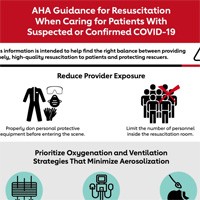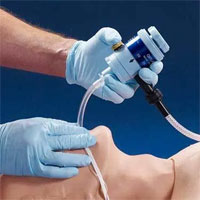Tag: resuscitation

CPR Algorithm Adjustments when Caring for Suspected or Confirmed COVID Cases
When caring for confirmed COVID-19 cases, it is essential for healthcare providers to protect themselves from exposure as best they can. Healthcare providers who contract COVID-19 can increase the burden on an already... read more

How I Manage Drainage Insufficiency on ECMO
As the use of extracorporeal membrane oxygenation (ECMO) expands, a systematic approach to the management of complex technical issues, such as drainage insufficiency, is essential to improving patient outcomes. Due to... read more

Small Compact Resuscitation Device Safely Used on Patient with COVID-19
A small compact and portable resuscitation ventilation device built by PRIMEDIC OXYLATOR, was safely used to treat a patient with COVID-19 pneumonia in the intensive care unit (ICU). The Oxylator from Primedic is a combination... read more

A Comparison of Albumin and Saline for Fluid Resuscitation in the ICU
In this randomized trial, we found that the use of 4 percent albumin or normal saline for intravascular volume resuscitation in a heterogeneous population of patients in the ICU resulted in equivalent rates of death from... read more

Guidelines for Burn Care Under Austere Conditions
The principles of care after disasters and mass casualty incidents are centered on doing the greatest good for the greatest number. From an airway and ventilation perspective, we have presented the issues that are likely... read more

Impact of Protocolized Diuresis for De-resuscitation in the ICU
Using a diuresis protocol for volume de-resuscitation, we demonstrated a significant decrease in net cumulative fluid balance at 72 h following shock resolution, with potential benefit on clinical outcomes including renal... read more

Association of Initiation of Dialysis with Hospital Length of Stay and Intensity of Care in Older Adults With Kidney Failure
In this cohort study, compared with non-dialysis care, patients who received maintenance dialysis spent more time in the hospital and were more likely to be admitted to intensive care units. This finding suggests trade-offs... read more

New Study on Prehospital Airway Control Trial Underway
Emory University Department of Emergency Medicine and Grady Memorial Hospital will take part in a U.S. Department of Defense-funded clinical trial to compare different ways to help people with traumatic injuries breathe. The... read more

Sudden Abdominal Pain with a Palpable Mass
Rectus sheath hematoma (RSH) is a rare cause of abdominal pain that is often overlooked when patients present for evaluation. The disease can mimic almost any other type of abdominal pathology, and thus the diagnosis is frequently... read more

Association Between Hypothermia/Ischemia Ratio and Functional Outcome From Out-of-Hospital Cardiac Arrest
Although a larger hypothermia/ischemia ratio was associated with good functional outcome after out-of-hospital cardiac arrest in this cohort, this association is primarily driven by duration of time to return of spontaneous... read more

The Faster Cooling Rate and More Stable Cooling Process in Endovascular Cooling Shorten Patients’ Time in ICU
This study conducted a meta-analysis to assess the effectiveness, stability, and safety of mild therapeutic hypothermia (TH) induced by endovascular cooling (EC) and surface cooling (SC) and its effect on ICU, survival rate,... read more

Potential Therapy for Improving Sudden Cardiac Arrest Resuscitation Outcomes
The severity of cardiogenic shock following asystolic cardiac arrest is dependent on the length of cardiac arrest prior to cardiopulmonary resuscitation and is mediated by myocardial stunning resulting from mitochondrial... read more

Guidelines for the Management of Septic Shock and Sepsis-Associated Organ Dysfunction in Children
A large cohort of international experts was able to achieve consensus regarding many recommendations for the best care of children with sepsis, acknowledging that most aspects of care had relatively low quality of evidence... read more

Epinephrine During Resuscitation of Traumatic Cardiac Arrest and Increased Mortality
Epinephrine administered during in-hospital resuscitation was associated with lower 7-day survival rate in patients with out-of-hospital cardiac arrest (OHCA) following trauma. While we examined the outcomes of selected... read more




